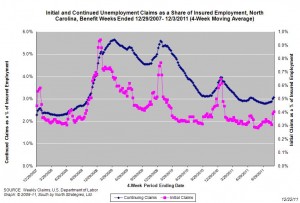04.01.2012
Policy Points
From the Federal Reserve Bank of Richmond’s latest survey of manufacturing activity in the South Atlantic (District of Columbia, Maryland, North Carolina, South Carolina, Virginia and West Virginia):
Manufacturing activity in the central Atlantic region firmed somewhat after stabilizing in November, according to the Richmond Fed’s latest survey. The index of overall activity edged higher as positive readings for shipments and new orders offset a slight decline in the reading for employment. Modest improvement was also evident in most other indicators. District contacts reported that backlogs turned positive and noted that capacity utilization steadied. Delivery times were virtually unchanged, while finished goods inventories grew at a slightly faster rate.
…
Looking ahead, assessments of business prospects for the next six months were less optimistic in December. Contacts at more firms anticipated that shipments, new orders, backlogs, capacity utilization and capital expenditures would grow more slowly during the next six months.
23.12.2011
Policy Points
Policy Points is taking some time off to celebrate the Christmas and New Year’s holidays. Regular posting will resume on January 4, 2011.
Also, South by North Strategies’ biannual review of the North Carolina labor market will appear in early January. This review will cover the trends of the last half of 2011 and review the year’s developments.
Thanks for your interest in Policy Points. Merry Christmas, and best wishes for 2012.
22.12.2011
Policy Points
Economic policy reports, blog postings, and media stories of interest:
22.12.2011
Policy Points
For the benefit week ending on December 3, 2011, some 13,553 North Carolinians filed initial claims for state unemployment insurance benefits, and 115,107 individuals applied for state-funded continuing benefits. Compared to the prior week, there were fewer initial and continuing claims. These figures come from data released by the U.S. Department of Labor.
Averaging new and continuing claims over a four-week period — a process that helps adjust for seasonal fluctuations and better illustrates trends — shows that an average of 15,149 initial claims were filed over the previous four weeks, along with an average of 114,208 continuing claims. Compared to the previous four-week period, the average number of initial claims was higher, as was the average number of continuing claims.
One year ago, the four-week average for initial claims stood at 16,362 and the four-week average of continuing claims equaled 123,741.
In recent weeks covered employment has increased slightly and has returned to the 3.73 million level recorded a year ago. Nevertheless, there are still fewer covered workers than there were in January 2008, which means that payrolls are smaller today than they were almost three years ago.
 The graph shows the changes in unemployment insurance claims measured as a share of covered employment in North Carolina since the recession’s start in December 2007.
The graph shows the changes in unemployment insurance claims measured as a share of covered employment in North Carolina since the recession’s start in December 2007.
Both new and continuing claims appear to have peaked for this cycle, and the four-week averages of new and continuing claims have fallen considerably. Yet continuing claims remain at an elevated level, which suggests that unemployed individuals are finding it difficult to find new positions.
22.12.2011
Policy Points
Mark Thoma explains how wealth disparities undermine economic efficiency and social well-being.
This is, of course, an argument for the government provision of certain types of goods through a tax structure that requires the wealthy to pay a larger share of the bill based upon efficiency rather than equity grounds, but here’s the problem. This only works if the rich and the poor live in the same neighborhoods, share the same roads, use the same parks, attend the same schools, and so on. In an increasingly divided economy and society – as in the US in recent decades – the opportunities for mutually beneficial arrangements diminish. If the wealthy do not attend the same schools, live in the same areas as the poor, have special lines at airports, shun public pools, have their own tennis courts, golf courses, and parks, if they have helicopters to avoid city traffic, their own security arrangements independent of the police – the list goes on and on – then these opportunities are lost.
Thoma’s article continues:
The more divided our society becomes, and the divisions are growing, the less shared experience we will have. The rich live in one world, the poor in another, and mutually beneficial arrangements between the two groups fail to occur.
And we are all worse off because of it.


 Email Sign-Up
Email Sign-Up RSS Feed
RSS Feed